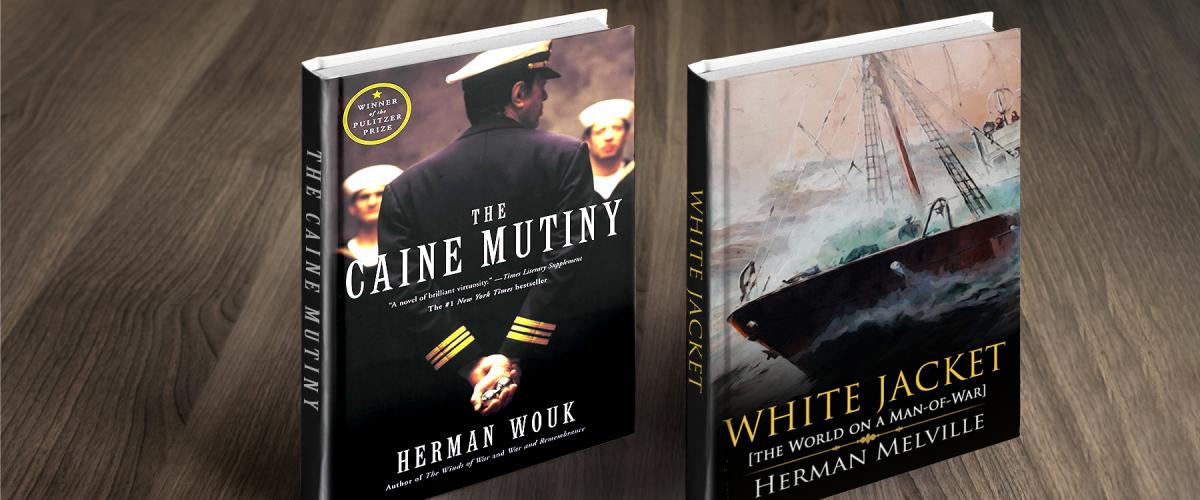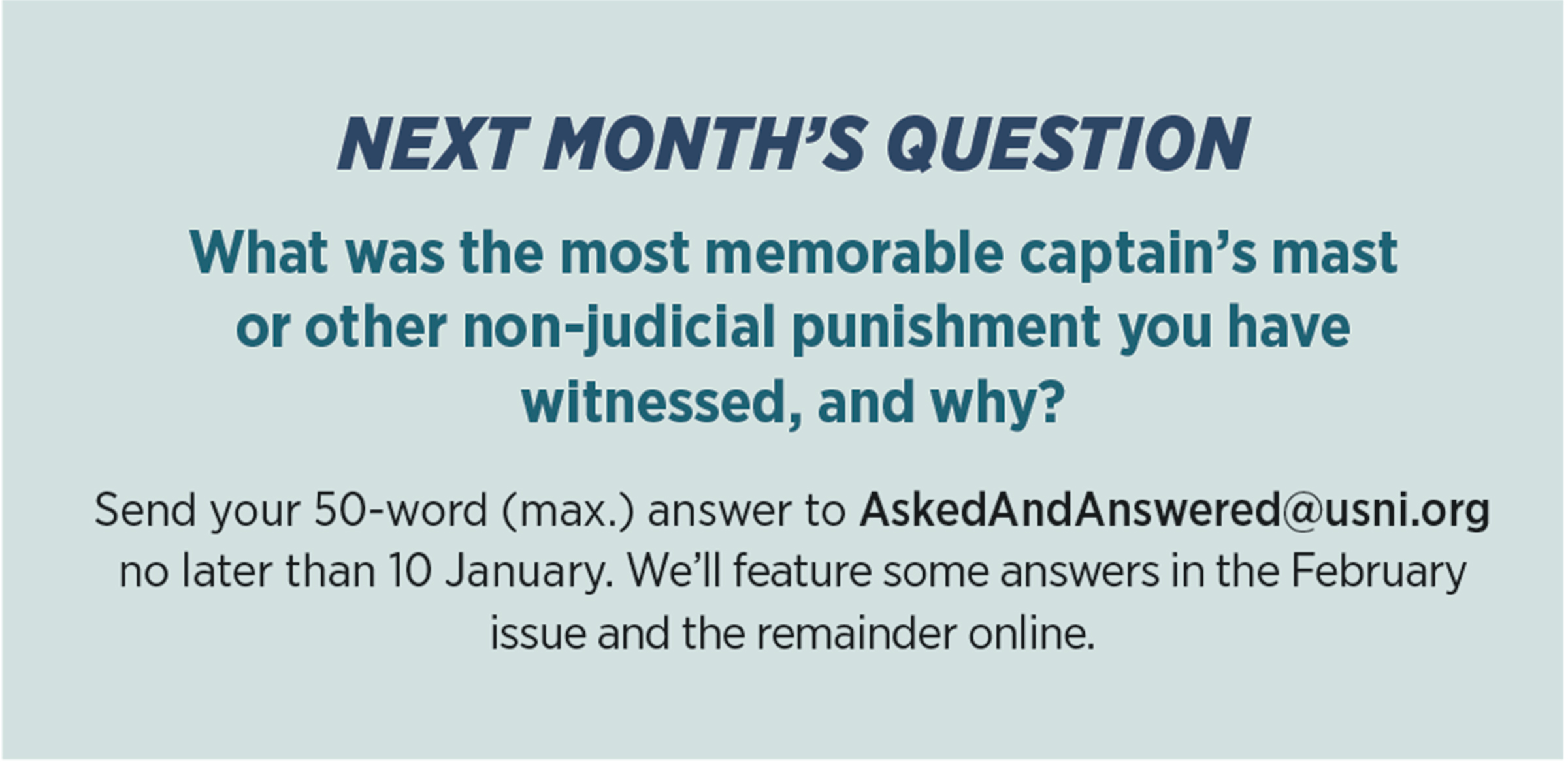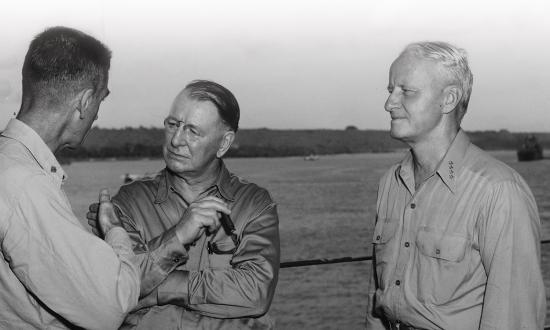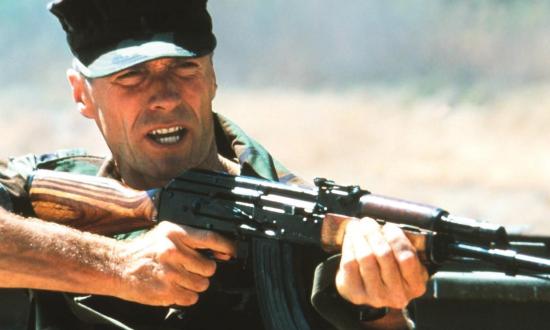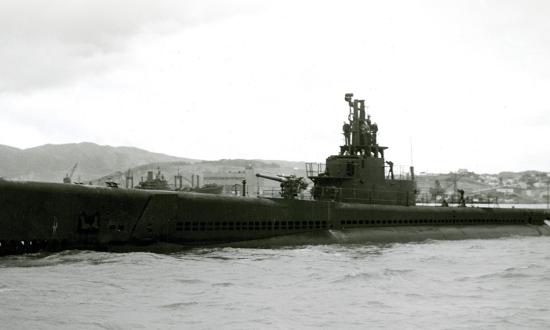Daryl P. Domning, Golden Life Member
Herman Melville’s novel White Jacket (1850), based on his 1840s experiences before the mast in the frigate United States. His graphic depictions of flogging, brought to the attention of Congress, were instrumental in the abolition of flogging throughout the Navy.
Captain Thomas R. Daniel, U.S. Navy (Retired)
The command-at-sea lessons of Herman Wouk’s Pulitzer Prize–winning novel The Caine Mutiny (1951) and classic film (1954) have stood the test of time. One would be hard pressed to find any successful current or former commanding officer who did not learn that the best command-at-sea lesson was to not be like Captain Queeg.
Winn B. Frank, Golden Life Member
The film Master and Commander: The Far Side of the World (2003), based on Patrick O’Brian’s 1969 novel. A classic command decision point: In a deep fog, an insecure officer of the deck catches a fleeting glance of a sail. Does he call general quarters and possibly incur the crew’s consternation if it is a false alarm? Or does he let it go and wait for a confirmation sighting?
Captain Walter D. Leventhal, U.S. Navy Reserve (Retired)
The film The Bedford Incident (1965). A dictatorial captain fails to heed the advice of his crew and pursues an enemy submarine with a catastrophic outcome. The main lessons are the need for clear communication and to avoid intimidating subordinates.
Commander Joel I. Holwitt, U.S. Navy
The play Mister Roberts (1948) by Thomas Heggen and Joshua Logan, based on Heggen’s novel. It reminds us that regardless of the assignment we draw, our leadership matters. All could benefit from Roberts’ realization that earning the crew’s loyalty means more than any medal.
Captain Daniel Schwartz, U.S. Merchant Marine (Retired)
Nicholas Monsarrat’s novel The Cruel Sea (1951) and companion book Three Corvettes (1953). The latter is an autobiographical story of his rise to command of an escort during the World War II Battle of the Atlantic.
Sean Skilling
Patrick O’Brian’s novel Desolation Island (1978) provides the best example of what makes a great commanding officer—involved, knowledgeable, unflappable, optimistic, sensitive, and realistic. Jack Aubrey sails his ship with great skill, fights his ship wisely when compelled, and saves his ship when another might have resigned himself to what seemed inevitable.
Chief Petty Officer John Duffy, U.S. Navy (Retired)
The film Greyhound (2020), based on C. S. Forester’s novel The Good Shepherd (1955). Commander Ernest Krause leads not only three other warships protecting convoy HX-25 in February 1942, but also the crew of the USS Keeling (DD-548) as they cross the “Black Pit” without Allied air cover.
Lieutenant Commander Rob Schmidt, U.S. Navy (Retired)
Herman Melville’s White-Jacket (1850), based on his experience as a common seaman on board the frigate United States (1843–44). Although shipboard life was very different (and often brutal) then, the concerns of the junior sailors and their criteria for assessing their leaders have relevance today.
Captain Murdock Moore, U.S. Air Force (Retired)
The film On the Beach (1959), in which Gregory Peck plays the USS Sawfish’s Commander Dwight Tower. The world is coming to an end as planet-killing post-nuclear war radiation drifts south toward Australia. Sailing north out of Melbourne looking for a “cool” zone, Peck exudes a quiet, smiling confidence to his daily nearer-to-death sailing crew.
David Fleenor, U.S. Navy Veteran
The one book (and excellent film adaptation) is Herman Wouk’s The Caine Mutiny (1952). It has countless examples of both good and, more importantly, bad leadership. It is also a great treatise on the importance of good “followership.” Oh, those steel balls!
Commander Greg Atchison, U.S. Navy (Retired)
The film Mister Roberts (1955). As the captain, James Cagney is a great example of a poor leader. By contrast, Henry Fonda is a great example of what a leader should be.
Alan Jaroslovsky, U.S. Navy Veteran
A too-old-for-the-role John Wayne in In Harm’s Way (1965), based on James Bassett’s 1962 novel, gives lessons in duty, honor, loyalty, leadership, and sacrifice. Also, he gives the best toast ever: “To our flag, our navy, and all the best things they stand for.”
Theodore Kuhlmeier, U.S. Marine Corps Veteran
C. S. Forester’s Hornblower series (1937–67). Horatio Hornblower, a Royal Navy captain during the Napoleonic wars, led his men with humanity and concern for their welfare. Though flogging was common in that era, Hornblower hated to use it or see it done. He also did not believe in his senior officers verbally abusing subordinates for minor mistakes in learning their duties.
Jim Fitzpatrick, U.S. Army Veteran
The film Ice Station Zebra (1968), adapted from Alistair MacClean’s 1963 novel, is outstanding for Rock Hudson’s portrayal of the submarine USS Tigerfish’s skipper, Commander James Ferraday. He was a man who inspired confidence, could lead his men into battle, and knew what he was doing.
Benjamin Turon
Rockwell “Rock” Torrey, played by John Wayne in the Otto Preminger film adaption (1965) of James Bassett’s 1962 novel In Harm’s Way, displays a leadership model that is affable and collaborative, yet also firm and decisive. Morally decisive, too—Torrey plays no favorites when dealing with a sexual assault.
Captain Eduard Vivas Flores, Spanish Navy (Retired)
The film Master and Commander: The Far Side of the World (2003) with Russel Crowe playing Captain Jack Aubrey, drawn from Patrick O’Brian’s 1969 novel, Master and Commander.
Captain Ray Brown, U.S. Coast Guard (Retired)
In both the novel and the film The Caine Mutiny, Lieutenant Commander Barney Greenwald’s dressing down of the assembled wardroom is full of lessons for any junior officer who aspires to one day command at sea. Learn early.
James Constantine
Victory at Sea, the 1950s documentary film series and original book set offer many lessons for any military officer and even enlisted personnel.
John Snyder, U.S. Navy Veteran
Herman Wouk’s The Caine Mutiny, the book (1952) and the film (1954).
Duane Rice-Mason
Tom Clancy’s Red Storm Rising (1986) is the most realistic and up to date piece of fiction regarding naval warfare.
Joel Weinbaum, U.S. Navy (Retired)
The film Mister Roberts for the madness of a maligned commanding officer. The Caine Mutiny (1953) for the portrayal of an over-correcting, under-skilled defensive commanding officer.
Captain Mark Nesselrode, U.S. Navy (Retired)
The film Greyhound (2020) accurately portrays the inescapable burden of command at sea and the bond the commanding officer must have with his crew. Tactical excellence is paramount, but the ability to overcome doubt and uncertainty are also clearly presented. These are all necessary elements for successful command at sea.
Louis H. Liotti
Herman Wouk’s 1951 Pulitzer Prize–winning novel The Caine Mutiny has not been equaled for the lessons it offers a prospective commanding officer. Wouk, a World War II naval officer, describes the challenges, prosaic and profound, encountered in naval command and the qualities of character needed to successfully meet those challenges.
Michael Romero
Despite its satirical nature, the film Down Periscope (1996) starring Kelsey Grammer has many valuable lessons for a first-time commanding officer. Pressure from senior officers, crew integration and culture, team building, mentoring of subordinates, toxic leadership, command initiative, and seeking tactical excellence are all poignantly, if humorously, explored.



